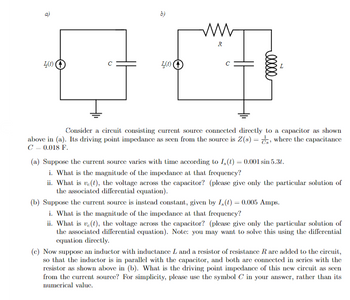
Elements Of Electromagnetics
7th Edition
ISBN: 9780190698614
Author: Sadiku, Matthew N. O.
Publisher: Oxford University Press
expand_more
expand_more
format_list_bulleted
Question
Please solve this fully for me, I need help on this fast :)

Transcribed Image Text:a)
b)
ww
R
45)
с
I(t)
C
00000
Consider a circuit consisting current source connected directly to a capacitor as shown
above in (a). Its driving point impedance as seen from the source is Z(s), where the capacitance
C = 0.018 F.
(a) Suppose the current source varies with time according to I,(t) = 0.001 sin 5.31.
i. What is the magnitude of the impedance at that frequency?
ii. What is ve(t), the voltage across the capacitor? (please give only the particular solution of
the associated differential equation).
(b) Suppose the current source is instead constant, given by I,(t)=0.005 Amps.
i. What is the magnitude of the impedance at that frequency?
ii. What is ve(), the voltage across the capacitor? (please give only the particular solution of
the associated differential equation). Note: you may want to solve this using the differential
equation directly.
(c) Now suppose an inductor with inductance L and a resistor of resistance R are added to the circuit,
so that the inductor is in parallel with the capacitor, and both are connected in series with the
resistor as shown above in (b). What is the driving point impedance of this new circuit as seen
from the current source? For simplicity, please use the symbol C in your answer, rather than its
numerical value.
Expert Solution
This question has been solved!
Explore an expertly crafted, step-by-step solution for a thorough understanding of key concepts.
Step by stepSolved in 2 steps

Knowledge Booster
Similar questions
- consider a crane with a 30 pound ball suspended from a 40 foot cable that weighs 5 pounds per foot.a) find the work required to wind up 15 feet of hte apparatus.b) find the work required to wind up all 40 feet of the apparatus.arrow_forwardA new type of energy absorber is being designed as a buffer at the end of track at a fairground.It consists of a piston with small holes that moves in a cylinder containing oil, so that the kineticenergy of impact is absorbed as heat by the oil.a) Draw a sketch for the instant of impact by a vehicle of mass 2500kg moving at 30mphshowing the forces and energy transfers involved.b) Write down the first law of thermodynamics for a system and identify terms that are notrelevant if the oil is taken as the system.c) How much heat transfer to the surroundings is required to return the oil to its originaltemperature after an impact by a 2500kg vehicle moving at 30mph?arrow_forward4.) Please help with equation, gravity is g=32.2 ft/sec^2 or g=9.81 m/sec^2arrow_forward
- A hydraulic motor has a 100cm3 volumetric displacement. If it has a pressure rating of 140 bars and receives oil from a 0.001 m3/s theoretical flow-rate pump, find the motor a) speed b) theoretical torque c) theoretical kW power (would you mind please showing your work so that I can study how to do it on my own? Thanks!)arrow_forward£1,7 0:-11 | ZAY O K/s Figure below shows a rod that is free to rotate about its center of mass. A force F, = 15 N is applied at d, = 4 m from the COM and another force F, = 17 N is applied at d, = 7 m from the COM, as shown. The magnitude of the total torque about the axis of rotation is: F1 600 COM 300 F2arrow_forwardCalculated a) as 16.554kN, b) as 26.003kN and c) as 0.637m Need help with d) and e)arrow_forward
arrow_back_ios
arrow_forward_ios
Recommended textbooks for you
 Elements Of ElectromagneticsMechanical EngineeringISBN:9780190698614Author:Sadiku, Matthew N. O.Publisher:Oxford University Press
Elements Of ElectromagneticsMechanical EngineeringISBN:9780190698614Author:Sadiku, Matthew N. O.Publisher:Oxford University Press Mechanics of Materials (10th Edition)Mechanical EngineeringISBN:9780134319650Author:Russell C. HibbelerPublisher:PEARSON
Mechanics of Materials (10th Edition)Mechanical EngineeringISBN:9780134319650Author:Russell C. HibbelerPublisher:PEARSON Thermodynamics: An Engineering ApproachMechanical EngineeringISBN:9781259822674Author:Yunus A. Cengel Dr., Michael A. BolesPublisher:McGraw-Hill Education
Thermodynamics: An Engineering ApproachMechanical EngineeringISBN:9781259822674Author:Yunus A. Cengel Dr., Michael A. BolesPublisher:McGraw-Hill Education Control Systems EngineeringMechanical EngineeringISBN:9781118170519Author:Norman S. NisePublisher:WILEY
Control Systems EngineeringMechanical EngineeringISBN:9781118170519Author:Norman S. NisePublisher:WILEY Mechanics of Materials (MindTap Course List)Mechanical EngineeringISBN:9781337093347Author:Barry J. Goodno, James M. GerePublisher:Cengage Learning
Mechanics of Materials (MindTap Course List)Mechanical EngineeringISBN:9781337093347Author:Barry J. Goodno, James M. GerePublisher:Cengage Learning Engineering Mechanics: StaticsMechanical EngineeringISBN:9781118807330Author:James L. Meriam, L. G. Kraige, J. N. BoltonPublisher:WILEY
Engineering Mechanics: StaticsMechanical EngineeringISBN:9781118807330Author:James L. Meriam, L. G. Kraige, J. N. BoltonPublisher:WILEY

Elements Of Electromagnetics
Mechanical Engineering
ISBN:9780190698614
Author:Sadiku, Matthew N. O.
Publisher:Oxford University Press

Mechanics of Materials (10th Edition)
Mechanical Engineering
ISBN:9780134319650
Author:Russell C. Hibbeler
Publisher:PEARSON

Thermodynamics: An Engineering Approach
Mechanical Engineering
ISBN:9781259822674
Author:Yunus A. Cengel Dr., Michael A. Boles
Publisher:McGraw-Hill Education

Control Systems Engineering
Mechanical Engineering
ISBN:9781118170519
Author:Norman S. Nise
Publisher:WILEY

Mechanics of Materials (MindTap Course List)
Mechanical Engineering
ISBN:9781337093347
Author:Barry J. Goodno, James M. Gere
Publisher:Cengage Learning

Engineering Mechanics: Statics
Mechanical Engineering
ISBN:9781118807330
Author:James L. Meriam, L. G. Kraige, J. N. Bolton
Publisher:WILEY